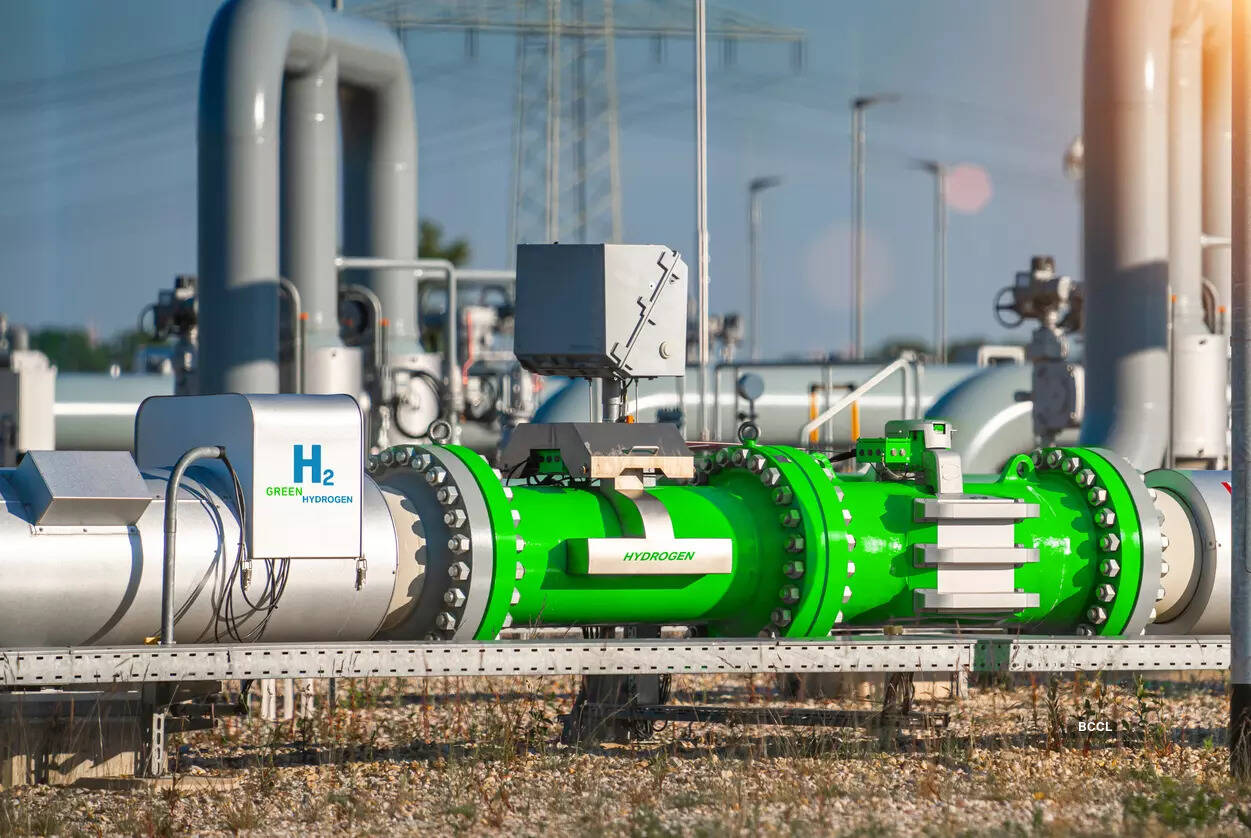
New Delhi: As India readies itself for rapid scaling of the domestic Green Hydrogen ecosystem, it is facing three key questions or hard choices, and its response will have implications for crucial areas such as sourcing of equipment, cost of supply for power consumers and demand creation at the level of industries.
The country is targeting to bring down the cost of production of Green Hydrogen to USD 1 per Kilogram (KG) as against USD 5-7 per KG currently, but it would be difficult to produce, use or export Green Hydrogen at a large scale without a high level of international collaboration.
It would require access to the supply chain of critical minerals, research in enhancing the efficiency of electrolysers and fuel cells, technology development for end use for blending of the gas for the heavy duty trucks and for converting ships to green methanol and for developing the infrastructure for storage and transport, and lastly, for the development of standards and certifications methodologies.
So, active international collaboration is the key to upscale the use of Green Hydrogen in India which is a very important intervention for combating climate change and also for taking the advantage of its strength of Green Hydrogen production.
“We have to ensure that we do not sound protectionist. The key question before India is this – whether to upscale Green Hydrogen on the strength of largely imported electrolysers and wait for the gradual localisation of electrolysers manufacturing, or choose the path of raising protections, like ALMM in solar equipment, for boosting local manufacturing of electrolysers and bear the cost of delayed expansion of Green Hydrogen. That is the dilemma between speed of expansion and localisation. The country will have to take a call, and fast,” said Alok Kumar, who superannuated as Secretary in the Ministry of Power on 30 June.
A solution is that, like in solar, initial expansion can be done using imports. So, the country should not rush for imposing protectionist measures like customs duty and allow for imports, and meanwhile it should develop the local industry through PLIs and other incentives. It should not sound protectionist, it must ensure it is seen as actually cooperating globally, and must not forget that other countries have already started talking about putting in place non-tariff barriers.
The second important consideration is around the cost of renewable energy for Green Hydrogen production. Around 60-70% of the cost is renewable energy itself. While the renewable energy cost in India is quite competitive, since it will involve transmission in large quantities across the country, the country has decided to waive off the cross-subsidy surcharge on interstate transmission charge on Green Hydrogen for projects which will come up by December 2030. That waiver would be available for 25 years. It is a huge step and a major incentive available for Green Hydrogen production.
“A key question here is: you might waive off ISTS charges but somebody will have to pay that transmission cost, as ultimately the cost of transmission is pooled and the states pay it collectively and it is passed on to the consumers finally as the cost of electricity. India will have to address this question in times to come – whether we will pass on the burden of the ISTS charge waiver to our consumers for exporting cheaper Green Hydrogen to other countries. That is a big policy issue and the country will have to take a call. This is doable for initial few projects but subsequently when you do it on a large scale, we will have to rethink,” Kumar said.
Similar to the case for Solar PV and wind energy, the Ministry of Power has brought a notification stating that beyond June 2025, it will only be a partial waiver. That means the companies will have to pay 25% for the first year, 50% for the second year, and so on.
Another related aspect of the Green Hydrogen ambition is banking. Green Hydrogen will require banking of Gigawatt scale, which no state power system can afford. Injection and withdrawal of, let us say, 5 GW power within a day’s time would require system capacity of the order that is not currently available. So, banking can be used only for marginal requirement. For most of their requirement, the Green Hydrogen producers will also have to set up storage capacities, either on their own or collectively through the captive route.
The country will have to work out the economics of Green Hydrogen production to understand whether it is still competitive after adding the cost of solar at INR 2.6 per unit, transmission losses, banking cost, storage cost etc. The production of Green Hydrogen in some countries like those in the Middle East, where the cost of capital is low and solar power cost is also lower than us, is cheap. It is important to decide whether India wants to subsidize exports at the cost of electricity consumers in India.
Lastly, unless an obligation is imposed for Green Hydrogen purchase a fast rollout will be difficult. Demand growth has to be visible for setting up electrolyser factories. A lot of investment is required in this area but banks will be wary of providing loans in the absence of clear demand. So, India has to decide quickly on imposing obligations.
Operationally, there are two routes available for this. First one is under the recent amendment to the Energy Conservation Act, there are possibilities of imposing the non-fossil fuel energy specific obligations on the designated consumers like the fertiliser plants, refineries etc. The second route is the carbon markets. Obligations can be imposed in the form of emission intensity caps and entities can opt for carbon trading. That will give some flexibility to the industries whether they go the Green Hydrogen route or they go for other available avenues for reduction of emission intensity.
“To my mind, India will have to go for imposing obligations specifically for Green Hydrogen, but if we have to do it as a national programme, we need to do it quickly,” Kumar said. An empowered committee chaired by the Cabinet Secretary is currently discussing this aspect, but imposing an obligation of this nature is bound to invite some criticism and questions may be asked on why does a poor country need to impose obligations that could jack up the cost of fertilisers and fuels.
Green Hydrogen — or clean Hydrogen, or low carbon Hydrogen — has emerged as one of the most important technologies that must be upscaled and developed in this decade so that it is available at full scale, or a scale similar to solar PV availability, by the beginning of the next decade. That is why this decade is very critical for scaling of Green Hydrogen.
The current Hydrogen consumption in the world is around 100 MT and it will rise to around 530 MTPA by 2050. It is mostly Grey Hydrogen and it contributes around 900 MT of CO2. When multiplied five times, it shows the world will see around 5-6 Giga Tonnes of CO2 by 2050 when we are targeting to reduce our global emissions to around 30-32 Giga Tonnes. That is why the focus on Green Hydrogen is critical. A bulk of this Green Hydrogen will be produced through electrolysis of water, while other promising technologies, including the use of biomass, are available too.
There are five major areas of work for developing Green Hydrogen ecosystem on a large scale. This includes supply of large quantities of critical minerals or rare earth minerals which are used for manufacturing electrolysers or fuel cells; large scale manufacturing of electrolysers and other systems; technology development because, based on the current efficiency levels of electrolysers, a lot of renewable energy is required to produce per Kilogram of Green Hydrogen; the production of Green Hydrogen itself, and finally, the users of Green Hydrogen.
On the production side of this global equation are countries like India who have huge renewable energy resources and have a developed ecosystem for producing renewable energy at competitive cost. Other countries will be large users of the fuel and that includes countries with large hard-to-abate industries and, therefore, requiring clean hydrogen but lacking in renewable energy supply.
India has the potential to become a large producer of Green Hydrogen and that may be an advantage. However, other countries may have the competitive advantage in the form of critical materials production. After 2030, India will also have its own obligations as a large user of Hydrogen. Currently, our NDCs do not envisage large scale use of Green Hydrogen for meeting our climate targets set forth in COP26 at Glasgow. The challenge is to upscale Green Hydrogen production at a rapid pace.
It is important to remember here that India can take some lessons from its Solar PV experience. In 2008, the cost of electricity production through Solar PV was INR 16 per unit and, therefore, it had very few takers. This changed, thanks to bold policy decisions, including Renewable Purchase Obligations (RPOs), and technology evolution. A large market was created, demand was aggregated and solar PV expanded at a rapid pace.
This was possible also because a few more advanced states, including Gujarat and Maharashtra, adopted aggressive installation and usage of solar power. India today needs something similar in Green Hydrogen. The country must use its competitive advantage and collaborate with other countries to develop the ecosystem.
The Intergovernmental Panel on Climate Change (IPCC) has projected that to limit the global rise in temperature to within 1.5 Degree Celsius, the available carbon budget was only around 500 Giga Tonnes of CO2 in 2020, and 86% of this budget will be consumed within this decade. Even if we take a relaxed approach and target the rise in temperature to 2 Degree Celsius, the available budget is just about 1,150 Giga Tonnes, and more than one-third of this will be consumed within this decade, and we would have hardly crossed the next decade when the available carbon budget would be exhausted.
This means that even if we are targeting to achieve Net Zero globally by 2050, not enough time or carbon budget is available. The INDCs received by the UNFCC Secretariat show a huge gap. In the NDCs submitted by various countries, most of them have focused on the supply of energy through renewable energy. Less than 50% of the countries have covered the interventions required in the industrial sector but many large industries consume energy not amenable to electrification. So, unless the humanity comes together and finds solution for industrial decarbonisation and heavy duty mobility, it would be difficult to avoid the worse effects of climate change.

